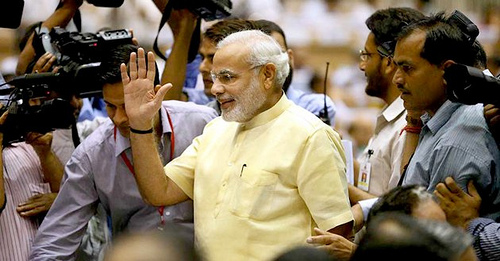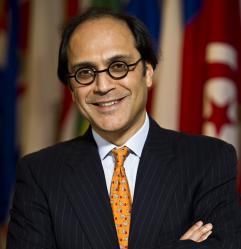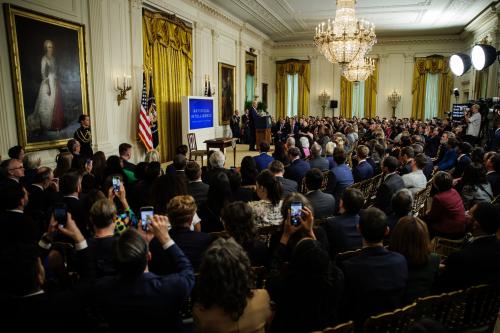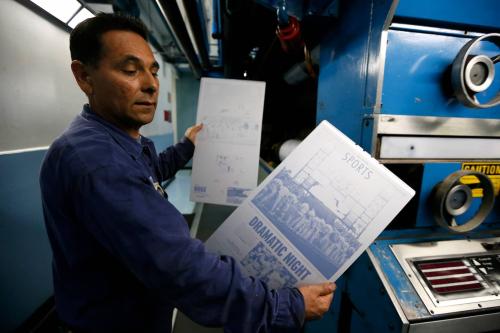Content from the Brookings Institution India Center is now archived. After seven years of an impactful partnership, as of September 11, 2020, Brookings India is now the Centre for Social and Economic Progress, an independent public policy institution based in India.
This article first appeared in the Harvard Business Review. The views are of the author(s).
Given political climates around the world and a new wariness around international cooperation, the private sector could find itself in the hot seat: trying to pick up the slack on big issues from climate change to sustainable development. This demand for taking on a larger role may come not only from advocacy and watchdog groups but also from customers, investors, partners, and employees.
The problem is that the private sector is not easily organized to create or bolster public goods. Despite the calls for corporate social responsibility and arguments for creating shared value, companies have not been moving very quickly to increase their activity in this space, with the exception of a few early movers.
I have previously made the case that the UN’s Sustainable Development Goals (SDGs) have the potential to provide, for the first time, a framework for mobilizing companies to invest in sustainable development in an ongoing and scalable way, while also pursuing their own business interests. And some companies have taken the lead. Unilever, for example, has found that its sustainable living brands are growing 30% faster than the rest of its business and in 2015 delivered nearly half the company’s total growth. Like Unilever, there are companies in other industries forming a vanguard of early movers, merging their business goals with sustainable development. I call this new breed of companies the “inclusive innovators.”
In order to understand this group better and learn how to extend their innovations to other firms in their industries, we launched a yearlong research effort (with support from Citi Foundation) over 2015–2016 to study 20 inclusive innovators spanning 10 industries. We conducted in-depth interviews with decision makers, including the CEOs or the senior executives responsible for sustainable development, and researched the company’s strategies and outcomes. Our primary findings are reported here. A key lesson is at the very outset: figuring out where to begin.
Navigating the SDGs: Where to Begin?
One of the first challenges for any company familiarizing itself with the 17 SDGs (listed in the chart below) is simply contending with their sheer breadth. The list of goals and publicity materials from the UN looks like a colorful game board and includes big ideas such as “no poverty,” “life on land,” and “peace and justice.”
Of course, the SDGs are meant to be comprehensive, a systemic approach to complex problems of sustainable development at a planetary level. But when confronted with a construct such as this, companies may struggle with where to begin. Trying to cover it all would be operationally overwhelming and a waste of resources. Some goals may be too broad or too distant. For example, “no poverty” is easy to write off as too far removed from a company’s business and value chain. While breadth is a virtue for a public policy audience, managers need ways to prioritize and focus resources.
The 20 companies we studied did not attempt to cover the spectrum of the SDGs; they made choices and allocated their resources. Some were more focused than others. For example, Southwest Airlines focused on responsible consumption and on climate action; Johnson & Johnson/Janssen chose good health and partnerships for the goals; and MasterCard chose good jobs and economic growth, reduced inequalities, and partnerships.
Some leaders worry that focusing on specific goals might lead to others being “orphaned.” Ericsson, for example, has assigned each executive team member as a champion of one of the SDGs. However, our research suggests that such dispersion of efforts is not advisable, as it tends to splinter resources, delink the SDG investments from company strategy, and have the paradoxical effect of making orphans out of all the SDGs because none gets the sustained strategic investments needed.
To get company managers with practical concerns started on the “where to begin” decision, we propose three steps, based on the experience of the inclusive innovators:
- Segment the SDGs. First, segment the SDGs relevant to your business into a “story” that helps establish a hierarchy and captures some of the logic about which ones are most relevant to you. One way to do this is to organize the SDGs into three main focus areas: people, planet, and policy principles. It’s useful to clarify which goals are end-state goals and which are intermediate goals designed to get to larger goals. You can see these focus areas in the chart below. (In our inclusive innovators report we organized the SDGs into a pyramid to represent the types of prioritization necessary, where each layer of the pyramid represents SDGs that collectively support the end-state SDGs that form the apex of the pyramid.)
- Identify where the company fits. The next step involves identifying which goals intersect with some part of the company or its value chain’s activities. These are places where the company can have meaningful impact and that can, in turn, have the widest and deepest impact in larger society. For example, Coca-Cola organized its activities around three areas: water, women, and well-being. Agribusiness Olam officially declared zero hunger its priority, and partnerships the way it would implement its initiatives. Our research revealed that it had an impact on clean water, good jobs and economic growth, and innovation and infrastructure as well.
- Make the business case. The last step is to identify business case factors that establish the commercial argument for where to play and why. Earlier research on the question of business case drivers found that there was no shortage of them among the companies we studied. The most frequently cited motivation was the reduction of business risks from the potential disruption of operations or risk of reputational damage, which was cited 38% of the time. This was followed by the motivation to adhere to industry norms of transparency, traceability, environmental responsibility, and other accepted standards, cited 27.6% of the time, and winning share in current markets and establishing a beachhead with future customers, cited 25.3% of the time. Building goodwill with key internal stakeholders was the least cited motivation, at 9%. At a macro level, the SDGs represent at least $12 trillion of market opportunities in just four areas: food and agriculture, cities, energy and materials, and health and well-being.
At a company level, the weaving of the business case and the case for sustainability is complex. The inclusive innovators we studied have developed that integrated case and a narrative about it. For maximum effectiveness, it comes from the top of the organization. Here’s how Art Peck, CEO of Gap, described it when we posed the question to him: “Our sustainability investments are based on the philosophy that we’re all connected, and positive actions we take to improve people’s lives and the planet are also essential to running a good business. When the people who make our clothes work in safe, fair conditions, they’re more productive and help us create better products. When we lower greenhouse gas emissions and reduce waste, we contribute to an environment in which our business can thrive.”
In 2017 it is imperative for a much wider swath of companies to recognize the alignment of business sustainability with sustainable development, as the private sector is called upon to fill a void created by the public sector’s retreat on broad, long-term global goals. It is equally critical to not allow the complexity and comprehensiveness of the goals to become a deterrent to corporate action.
Given that the SDGs provide a powerful framework for companies to mobilize, organize both internally and with partners, and take action, the first step is to stop trying to visualize the entire SDG framework, and frame it as a hierarchy of connected and sequenced goals. This helps prioritize and build a logic for choice and to integrate the strategy for building a sustainable business with the company’s strategy for engaging in sustainable development. Companies that take this first step can join the league of the inclusive innovators.










Commentary
Op-edHow Companies Can Champion Sustainable Development
March 15, 2017